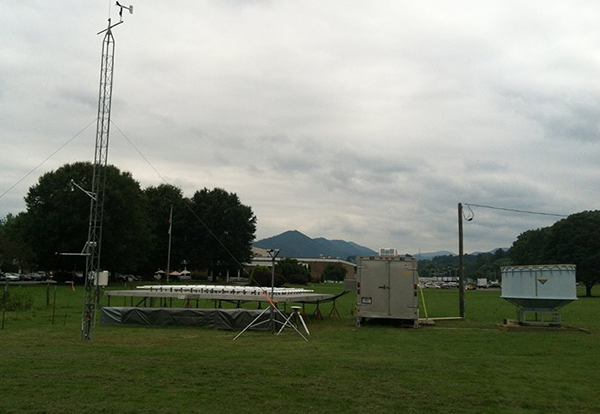HMT-Southeast Pilot Study Concludes
November 28, 2014
As of November 2014, the HMT-Southeast Pilot Study (HMT-SEPS) is concluding its ~16-month field deployment period. HMT-SEPS has been a successful field project and a foundation upon which many meaningful research-to-operations/applications partnerships have been built. The objective of the HMT-Southeast Pilot Study was to provide advanced hydrometeorological observations focused in western North Carolina, with some instrumentation also located in central and coastal NC. The project was made possible by partnering with NASA's IPHeX ground validation campaign, and HMT-SEPS was also able to identify and pursue several key Southeast-focused "science questions" targeting operationally-relevant heavy-precipitation-related topics.
While the HMT-SE Pilot Study has officially ended, some aspects of the regional effort will continue. First, the New Bern, NC Atmospheric River Observatory (ARO) will remain in place for an additional 12 months (through November 2015), and three new AROs at Johns Island, SC, Moss Point, MS and Sydney, FL will operate through November 2015. Observations can be accessed here. Research studies on a number of topics (some examples provided below) will also continue with support provided by NOAA ESRL PSD and the Sandy Supplemental funding award. Several collaborative efforts will also continue (e.g., NCSU/CSTAR, QPE/OHD) thanks to external support as well.

NOAA HMT intends to remain engaged with the HMT-Southeast community as progress is made on research efforts, and HMT also plans to continue to serve the community by continuing to host HMT-SEPS observations for download, as well as remain available for future collaborations on relevant regional endeavors. For additional information on HMT-SEPS in general, earlier documents can be found here and the HMT-SEPS Facebook page provides a useful timeline of HMT activities and events in the region.
Some select HMT-SEPS accomplishments are listed below:
Observations, Instrumentation, and Field Deployment
- Four wind profiling radars and six surface meteorology sites were installed by NOAA HMT. Most of this instrumentation (with the exception of New Bern, NC) will be removed from the field beginning October 2014.
- Two NC DENR/DAQ-owned wind profilers (Clayton, NC and Charlotte, NC) were repaired/upgraded and brought back on-line. These systems will continue to operate under the NC DENR/DAQ and data will continue to be available online through HMT and MADIS.
- Observations have been available in real-time for all users since 2013, and archived data will remain available for download and data analysis.
- HMT supported additional radiosonde balloon launches during IPHeX thanks to UNC-Asheville faculty and students.
- HMT supported gap-filling radar observations during IPHEX thanks to NSSL staff and students from the Univ. of OK.
- Support from the NOAA Hurricane Sandy Supplemental (Disaster Relief Act) has allowed us to add three new Atmospheric River Observatories in the Southeast; these will remain through the 2015 hurricane season.
Research
- HMT-SEPS research has been driven by the following main themes:
- The Climatology of Southeast US Extreme Precipitation Events (Lead by ESRL PSD, B. Moore et al. 2014 (MWR, in press))
- SE US QPF error climatology (Efforts ongoing at ESRL PSD, North Carolina State University; Baxter et al. 2014)
- Case Studies of heavy precipitation events (e.g., a 2013 western NC flash flood)
- Heavy precipitation processes and the relevance of "atmospheric rivers" to heavy SE precipitation (Efforts ongoing at ESRL PSD)
- Bulk microphysical characteristics of NC precipitation observed with disdrometers and vertically pointing precipitation profilers; assess performance of default NEXRAD rainfall algorithms. (ESRL PSD)
- Performance assessment of radar, gauge, and multi-sensor QPE in the upper Catawba river basin (ESRL PSD, OHD)
- Work along all of these themes will continue into FY15 thanks in large part to support from the Sandy Supplemental funding. We plan to keep posting publication information and presentations on research findings on the HMT-Southeast Documents page.
Collaborations and Partnerships
- We have been incredibly fortunate to have established fruitful partnerships with many groups and individuals in our HMT-Southeast community. From supporting university students to learning from WFO forecasters who have been in the trenches during heavy precipitation events of interest, any success that HMT-SEPS can claim is very much attributable to our interactions with all of you.
- Some of our key partnerships over the past few years have included: NASA, Duke, NCSU, CSTAR/USWRP, UNCA, NCAR, WPC, NSSL, NWS Eastern Region, and NWS WFOs (GSP and RAH in particular!). This is by no means a complete list, and it has been our pleasure to work with everyone in this uniquely engaged and motived meteorological community.
Contact: Kelly Mahoney